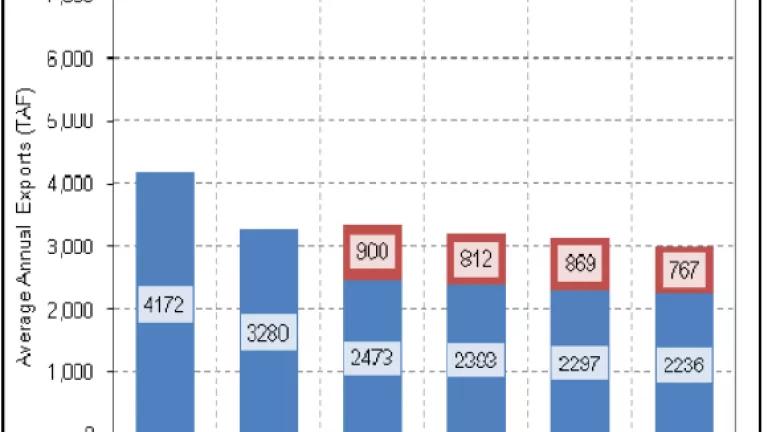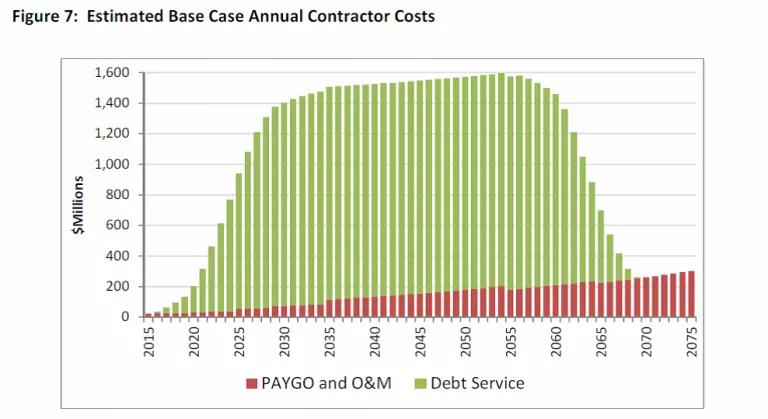
"Everyone has a plan until they get punched in the mouth."
California's drought, now in its fourth year and showing no signs of abating, is causing terrible hardship and impacts across the state to rural communities, agricultural users, and fish and wildlife populations. The drought has been a proverbial punch in the mouth, and the drought - and California's response to it - raise important questions about the viability and wisdom of the draft Bay Delta Conservation Plan (BDCP). So what does that punch in the mouth (drought) mean for BDCP?
What Lessons does the Drought hold for Water Users Considering Paying for BDCP?
State and federal agencies, as well as many of the water districts considering paying for BDCP, have repeatedly said that BDCP will not result in increased water exports from the Delta. Indeed, BDCP modeling shows that water deliveries would be lower than today in dry and critically dry years (see column on the far right, the so called "high outflow scenario," in the graph below), but would be higher than today in wet years, in order to achieve roughly the same level of exports as today once the impacts of climate change are accounted for.
(Source: BDCP DEIS/DEIR Figure 5-19)
Even as water contractors receive slightly less water than today from the State Water Project and Central Valley Project, the cost of that water in dry years like this one will skyrocket. After all, these contractors will owe more than $1.4 billion per year in annual debt financing costs after 2030 to pay back the cost of constructing the tunnels and diversion facilities. Assuming that the Metropolitan Water District of Southern California pays for ¼ of the cost of BDCP, that would be more than $300M each year that local water districts in Southern California can't spend on water recycling, water conservation and efficiency, or other local water supply projects. And for agricultural contractors like Westlands Water District or Friant Water Authority, both of which are likely to receive little to no water from the Central Valley Project this year, BDCP would add hundreds of millions of dollars in additional debt costs in a year like this. And this money will be owed to Wall Street; it won't be owed to state or federal governments that could waive interest charges or charge less than the cost of repaying the debts (like the Bureau of Reclamation has done for decades for the Central Valley Project) .

(Source: Blue Sky Consulting 2014)
It's worth noting that many of the districts that are weathering the drought the best so far in Southern California are those who have diversified water supply portfolios, including significant efforts on water conservation and efficiency, and built local storage to save water from wet years. Los Angeles, for instance, is planning aggressive efforts to further reduce reliance on the Delta and invest in local water supplies like water recycling, stormwater capture, and groundwater storage and cleanup. But all of that will take money, and as the University of Southern California noted in a 2012 report, "All of these elements require substantial investment to ensure a sustainable water supply future for the State. Some investments, such as the SWP proposed tunnels will preclude others due to financial constraints."
What Lessons does the Drought hold for Water Users in the Bay-Delta?
Farmers and cities in the Delta have been some of the most vocal critics of the tunnels. One of the most often vocalized fears is that with a new tunnel North of the Delta, the state and federal water projects would divert most or all of the Sacramento River's flow in dry years, turning the Delta into a salty, inland sea. A new 9,000 cfs diversion facility on the Sacramento River physically could divert all of the freshwater flow from the Sacramento River during most of the year in dry years like 2014 and 2015 (except during storms), although the BDCP plan indicates that they would not do so.
Last year, largely in response to drought conditions, the State Water Resources Control Board waived or greatly weakened most salinity and Delta outflow standards, generally requiring only the minimum salinity standard necessary for the operation of the state and federal water projects. The Board moved D-1641's water quality (salinity) standards for Delta agriculture in the summer months upstream by 3 miles. But because of the need to maintain the salinity barrier for water deliveries from the CVP and SWP, further reductions in delta outflow and salinity were not proposed. Indeed, half of the water that was not diverted or stored upstream and actually made it to the Delta in 2014 was used to maintain the salinity barrier to enabled continued water exports by the SWP and CVP.

(Source: SWRCB 2015)
If the SWP and CVP had a new diversion facility north of the Delta, would the CVP and SWP ask the State Water Resources Control Board to waive salinity standards in the Delta, enabling them to divert more water into the new tunnels, but causing seawater to intrude into the Delta and causing farms (and municipal contractors like Contra Costa Water District) to be forced to divert saltwater or stop diverting water altogether? What would the political reaction be to a virtually dry peripheral tunnel north of the Delta, and the idea that water is flowing past the tunnels into the Delta?
What Lessons does the Drought hold for conservation of fish and wildlife under BDCP?
As I've noted previously, the drought and the repeated waiver of environmental protections for fish and wildlife in response to drought conditions are predictably causing devastating impacts to our state's native fisheries. In 2014, the State Water Resources Control Board repeatedly waived or weakened water quality standards protecting fish and wildlife in the Delta, including Delta inflow, Delta outflow, and export limits. The Board recently granted another waiver of standards in 2015, but denied petitions from DWR and the Bureau of Reclamation to make environmental conditions worse than 2014 in light of the unreasonable impacts to fish and wildlife that resulted last year. In 2014, the National Marine Fisheries Service and U.S. Fish and Wildlife Service have repeatedly allowed water exports by the CVP and SWP in excess of the limits required to protect salmon and other native fish listed under the Endangered Species Act, and the California Department of Fish and Wildlife has done the same for fish listed under the California Endangered Species Act. Even though both the water quality standards under Decision 1641 and the biological opinions under the ESA include specific provisions for dry and drought years (here are some examples of how these standards generally provide far weaker environmental protections in drier years).
Delta outflow is one of the most important factors affecting the health of the estuary and its native fisheries. Higher Delta outflow is associated with more abundant populations of native fisheries (like longfin smelt), higher survival rates for salmon migrating through the delta, and improved water quality. In contrast, reduced Delta outflow has helped lead to invasions by exotic species (like Asian clams), increased harmful algal blooms, and reduced abundance and survival of native fisheries.
Despite the fact that existing water quality plans and endangered species act permits already, by their own terms, require reduced environmental protections during drought conditions, state and federal agencies have weakened or waived those standards even further. And of course, some water users have been lobbying Congress to go further and to preempt and undermine laws protecting the environment in order to divert even more water, even though the drought, not environmental laws, is the overwhelming cause of low water supplies.
What does this mean for BDCP? As the graph above shows, BDCP proposes that water diversions in dry and critically dry years would be lower than today. But if there were two huge tunnels and 9,000 cfs export capacity North of the Delta, would state and federal agencies actually implement the plan's required Delta outflow for fish and wildlife? Or would they override the rules, reducing outflow and waiving rules limiting pumping from the new intakes to protect migrating salmon? Would water users succeed in convincing Congress to override the rules?
Conclusion
The drought is causing significant hardship across the state. State and federal agencies have tried to manage the drought and choose the least bad option amongst bad options. While the biological science shows how important delta outflow and other environmental protections are for the continued existence of native fish, wildlife and the people who make their homes and living on these natural resources, the political science in favor of increasing diversions and waiving these standards has often trumped the biological science. The fact that the State Water Resources Control Board has overallocated water rights in the Bay-Delta watershed (with five times as many water rights as water in an average year, according to this University of California study) means that in dry years there just isn't enough water to go around. Our seemingly inequitable water rights system means that some users get full deliveries while others get no water, which serves to increase political pressure to increase water diversions
And obviously, all of these lessons can't all be true simultaneously. For instance, if Delta outflow standards are waived in future droughts that would increase water supplies under BDCP -- but it would also worsen environmental conditions for fish and wildlife, as well as likely causing more harm to Delta farmers and cities. The numerous scientific peer reviews demonstrate that BDCP needs to increase winter/spring Delta outflow and other flow conditions compared to what was proposed in the plan, not increase water exports and reduce outflow even further.
The drought also shows that BDCP will need to address the problem of reservoirs going to dead pool more frequently as a result of climate change. The BDCP plan claims that it won't worsen upstream conditions, but it does nothing to address conditions, like those last year that resulted in lethal water temperatures below Shasta Dam that helped kill more than 95% of endangered winter run Chinook salmon in 2014. Simply repeating the status quo is bad for wildlife, fisheries, and water users.
Another clear lesson of the drought is that reducing reliance on water from the Delta, by investing in local water supplies to have a diverse portfolio of water sources, is critical to sustaining both the health of the Delta's native fisheries and the economy of the State. Those regions with diverse water supply portfolios have generally weathered the drought better than parts of the state that are most reliant on the Delta. That will require significant financial investments in more efficient irrigation systems, groundwater storage and cleanup, stormwater capture, wastewater recycling, and improved urban water use efficiency. The money spent on BDCP is money that can't be spent on these new water supplies.
But by waiving environmental rules during the drought, and by lobbying Congress to override the ESA and other environmental laws, the response to drought has significantly undermined trust that a new facility would be operated according to the BDCP plan. As Mike Tyson said, "everyone has a plan until they get punched in the mouth."
